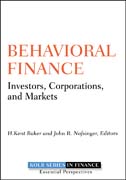
Behavioral finance: investors, corporations, and markets
Baker, H. Kent
Nofsinger, John R.
A definitive guide to the growing field of behavioral finance This reliable resource provides a comprehensive view of behavioral finance and its psychological foundations, as well as its applications to finance. Comprising contributed chapters written by distinguished authors from some of the most influential firms and universities in the world, Behavioral Finance provides a synthesis of the most essential elements of this discipline, including psychological concepts and behavioral biases, the behavioral aspects of asset pricing, asset allocation, and market prices, as well as investor behavior, corporate managerialbehavior, and social influences. * Uses a structured approach to put behavioral finance in perspective * Relies on recent research findings to provide guidance through the maze of theories and concepts * Discusses the impact of sub-optimal financial decisions on the efficiency of capital markets, personal wealth, and the performance of corporations Behavioral finance has quickly become part of mainstream finance. If you need to gain a better understanding of thistopic, look no further than this book INDICE: PART I. FOUNDATION AND KEY CONCEPTS. Chapter 1. Behavioral Finance: An Overview (Kent H. Baker, John R. Nofsinger). Chapter 2. Traditional versus Behavioral Finance (Robert J. Bloomfield). Chapter 3. Behavioral Finance: Application and Pedagogy in Business Education and Training (Rassoul Yazdipour, James A. Howard). Chapter 4. Heuristics (Rules of Thumb) (Hugh Schwartz ). Chapter 5. Neuroeconomics and Neurofinance (Richard L. Peterson). Chapter 6. Emotional Finance (Richard J. Taffler, David A. Tuckett). Chapter 7. Experimental Finance (Robert J. Bloomfield, Alyssa Anderson). Chapter 8. The Psychology of Risk and Uncertainty (Victor Ricciardi). Chapter 9. Psychological Influences on Financial Regulation and Policy (David Hirshleifer, Siew Hong Teoh). PART II. PSYCHOLOGICAL CONCEPTS AND BEHAVIORAL BIASES. Chapter 10. Disposition Effect(Markku Kaustia). Chapter 11. Prospect Theory and Behavioral Biases (Morris Altman). Chapter 12. Cumulative Prospect Theory (Haim Levy). Chapter 13. Overconfidence (Markus Glaser, Martin Weber). Chapter 14. The Representativeness Bias (Richard J. Taffler). Chapter 15. Familiarity Bias (Hisham S. Foad). Chapter16. Limited Attention (Siew Hong Teoh and Sonya S. Lim). Chapter 17. Other Behavioral Biases (Michael Dowling, Brian M. Lucey). PART III. BEHAVIORAL ASPECTS OF ASSET PRICING. Chapter 18. Market Inefficiency (Raghavendra Rau). Chapter19. Preference and Belief Based Models (Adam Szyszka). PART IV. BEHAVIORAL CORPORATE FINANCE. Chapter 20. Enterprise Decision Making as Explained in Interview-Based Studies (Hugh Schwartz). Chapter 21. Financing Decisions (Dirk Hackbarth). Chapter 22. Capital Budgeting and Other Investing Decisions (Simon Gervais). Chapter 23. Dividend Policy Decisions (Itzhak (Zahi) Ben-David). Chapter24. Loyalty, Agency Conflicts and Corporate Governance (Randall K. Morck). Chapter 25. Initial Public Offerings (François Derrien). Chapter 26. Mergers andAcquisitions (Ming Dong). PART V. INVESTOR BEHAVIOR. Chapter 27. Trust Behavior: The Essential Foundation of Financial Markets (Lynn A. Stout). Chapter 28.Individual Investor Trading (Ning Zhu). Chapter 29. Individual Investor Portfolios (Valery Polkovnichenko). Chapter 30. Cognitive Abilities and Financing Decisions (George M Korniotis, Alok Kumar). Chapter 31. Pension Participant Behavior (Julie R. Agnew). Chapter 32. Institutional Investors (Tarun Ramadorai).Chapter 33. Derivative Markets (Peter Locke). PART VI. SOCIAL INFLUENCES. Chapter 34. The Role of Culture and Finance (Rohan Williamson). Chapter 35. Social Interactions and Investing (Mark Seasholes). Chapter 36. Mood (Tyler Shumway). Part VII. Answers to Chapter Discussion Questions. Index.
- ISBN: 978-0-470-49911-5
- Editorial: John Wiley & Sons
- Encuadernacion: Cartoné
- Páginas: 768
- Fecha Publicación: 13/10/2010
- Nº Volúmenes: 1
- Idioma: Inglés
